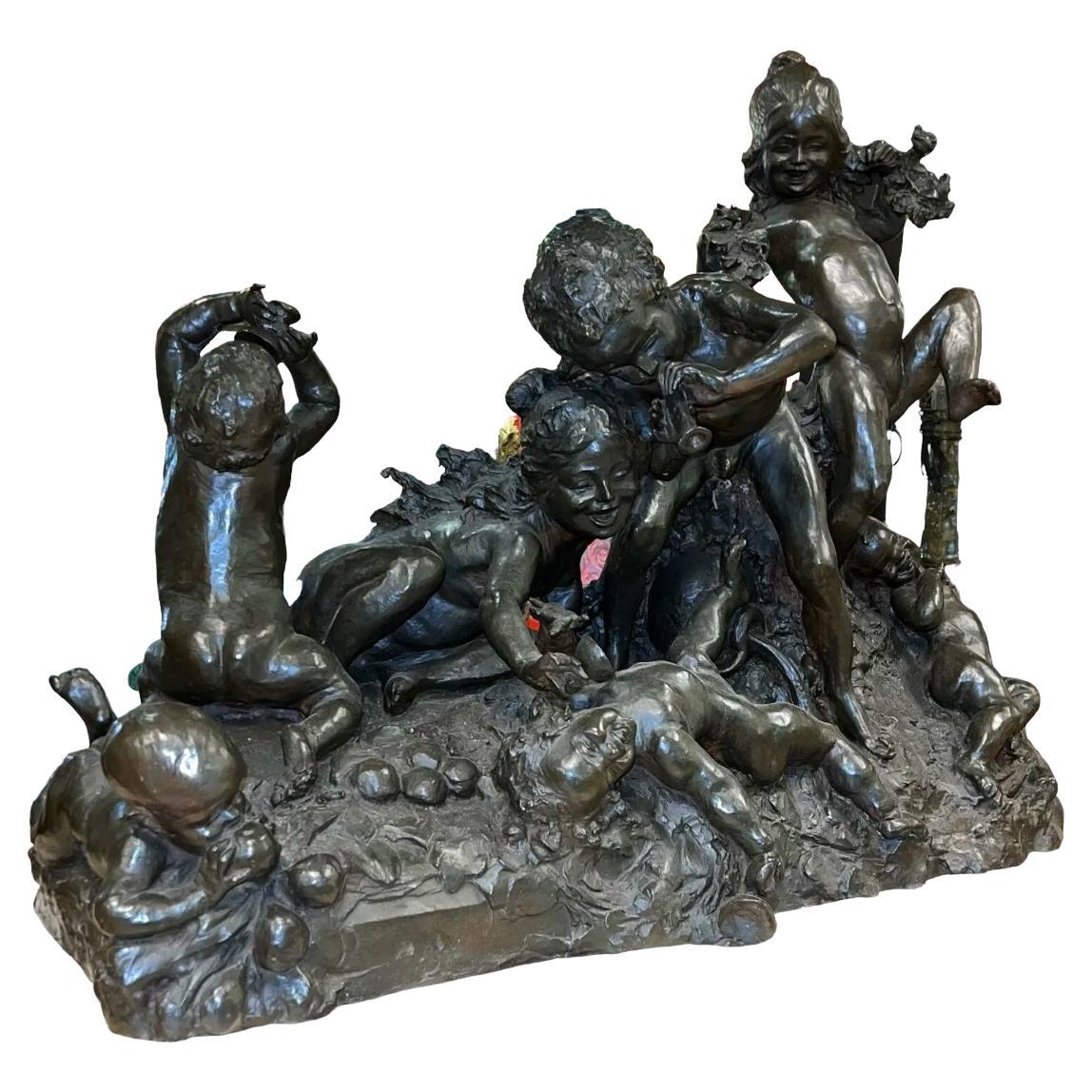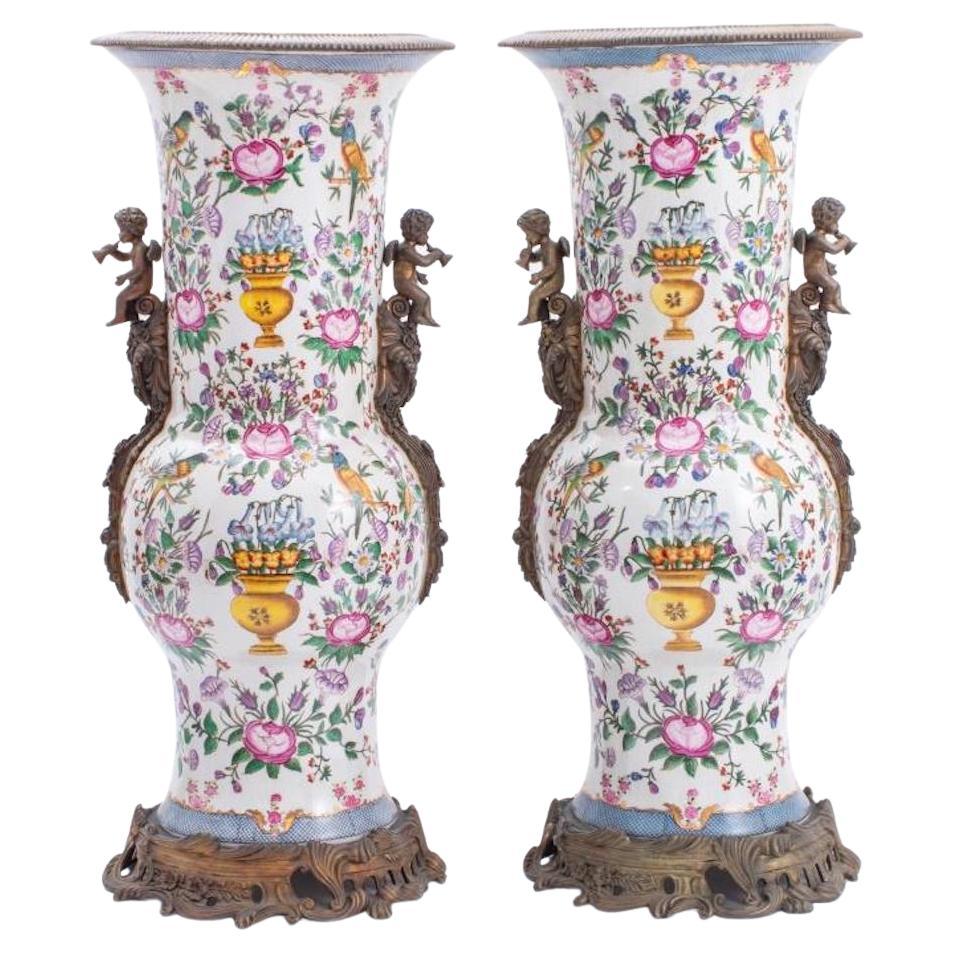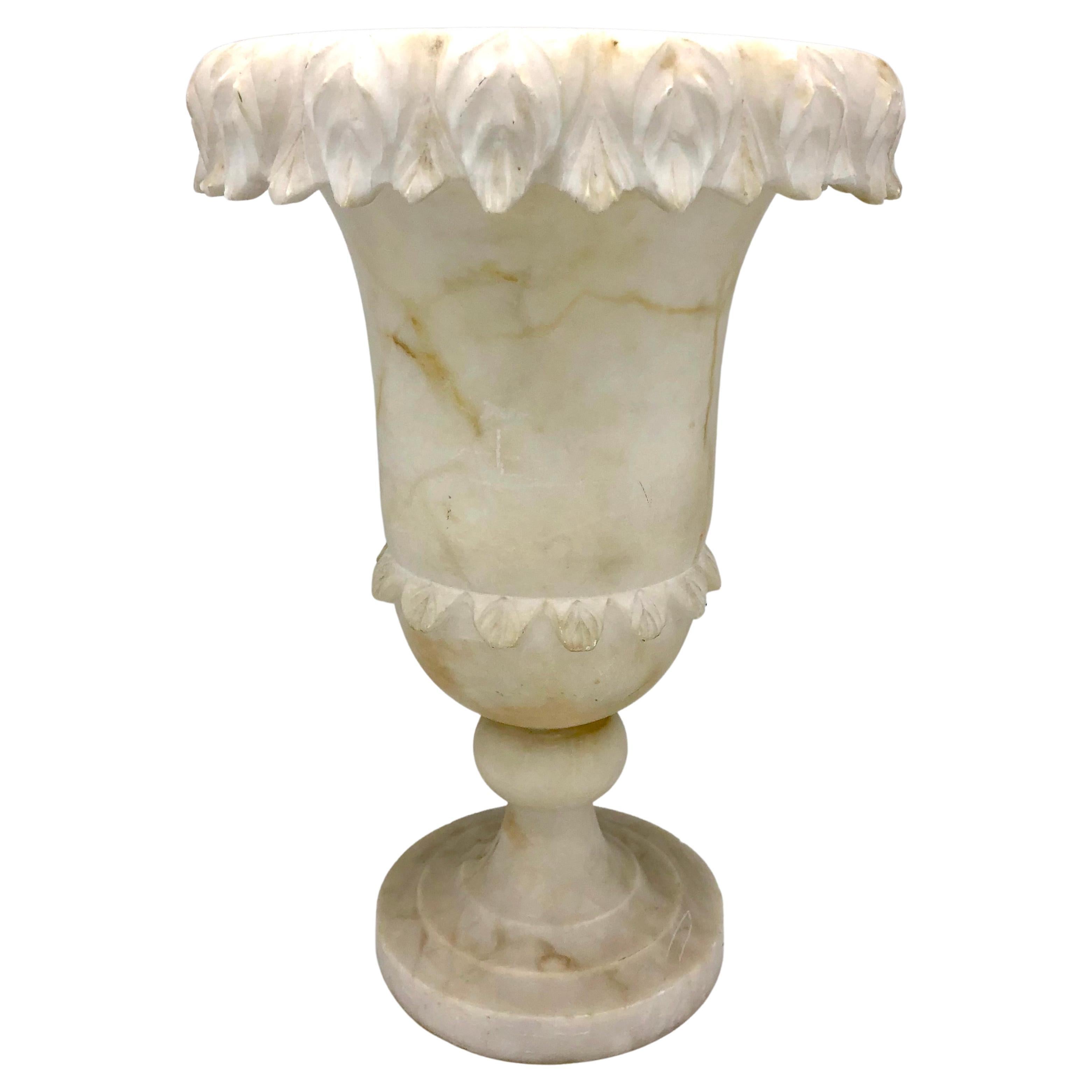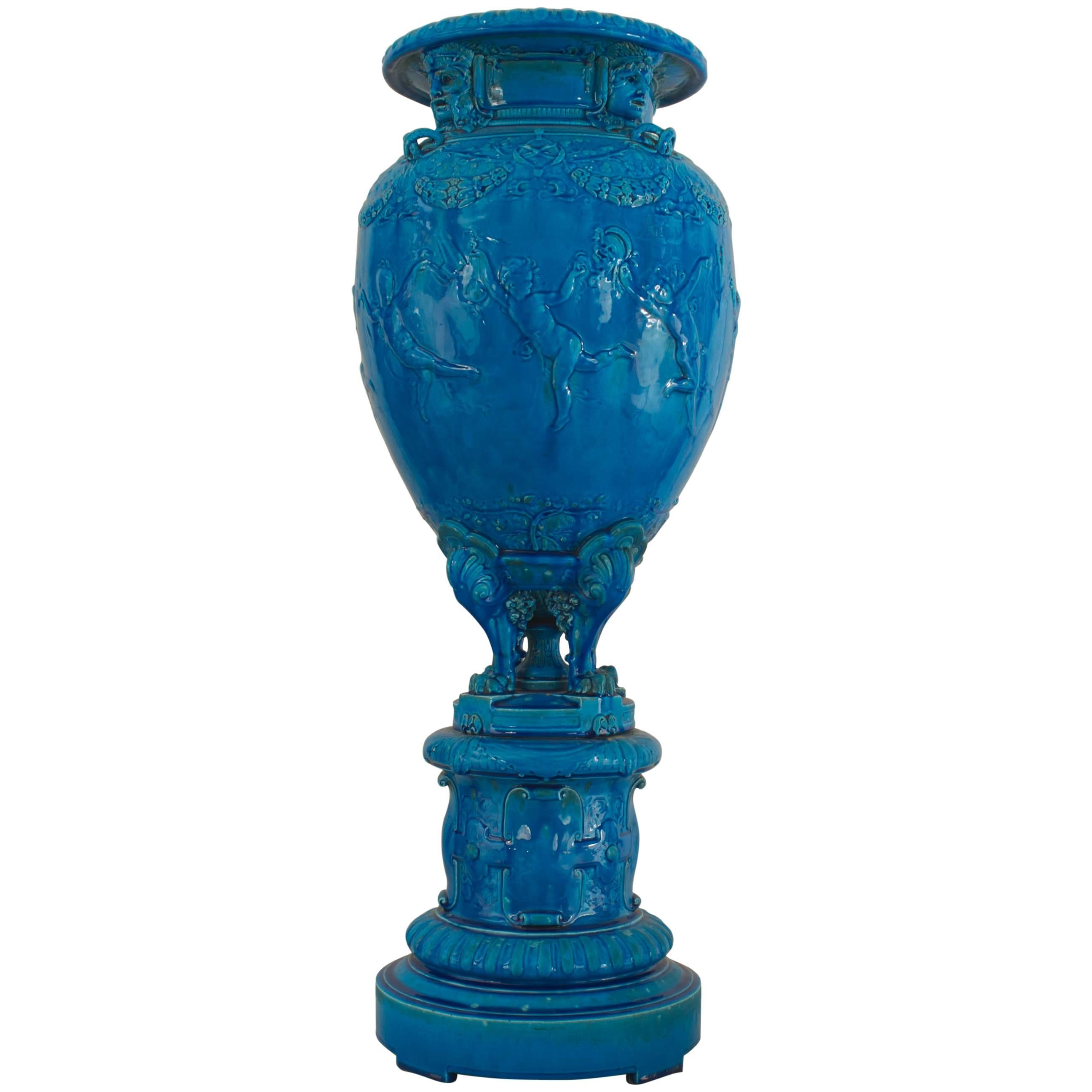Items Similar to Gustave-Joseph Chéret, French Belle Époque Figural Bronze Vase, ca. 1885
Want more images or videos?
Request additional images or videos from the seller
1 of 9
Gustave-Joseph Chéret, French Belle Époque Figural Bronze Vase, ca. 1885
About the Item
Gustave-Joseph Chéret
French Belle Époque
Patinated Bronze Figural Flower Vase
ca. 1882
Signed ‘Joseph Chéret’ and E. Soleau. Editr. Paris
Exquisitely cast by the famous Paris foundry of Eugene Soleau, this outstanding sculptural flower vase features a picturesque group of babies frightened by two big frogs. The vase has beautiful dark-brown patina and features original tin water container insert.
Joseph Gustave Chéret (1838 – 1894) was a French sculptor and ceramist. Son of Marie Nicolas Chéret and Justine Ormeau, Joseph Chéret was first trained as an ornamentalist, before becoming, around 1864, one of the principal assistants of the sculptor Albert-Ernest Carrier-Belleuse, one of whose daughters he married in 1868. Auxiliary precious for his father-in-law, he takes care of the daily business of his Paris studio at no. 15 rue de la Tour d'Auvergne. He assimilated the style of his master while building a modest independent reputation with works he sent to the Salon of French artists in 1863. Until 1873, he collaborated with ornamental houses like Christofle in Paris, and Pallemberg in Vienna, Austria.
When Carrier-Belleuse died in 1887, Joseph Chéret briefly assumed the position of director of works of art at the Sèvres factory, which remained vacant. In 1891, he exhibited at the National Society of Fine Arts of which he became a member in 1894.
Joseph Chéret is the author of numerous sculptures of small dimensions, groups and statuettes, but also vases, planters that adorn characters, scenes and various motifs. His Neo-Baroque work announced in many ways the newly-born Art Nouveau movement. He also created some decorations, fountains, and monumental fireplaces executed for mansions. Chéret is also the creator of the shape and decor of the first salamander (round model or fan model) that he launched in collaboration with the house Chaboche.
After his death in1894, his works were exhibited at the Ecole des Beaux-Arts in Paris, and then dispersed at the Hotel Drouot from 26 to 29 December 1894.
- Creator:Gustave-Joseph Chéret (Sculptor)
- Dimensions:Height: 14.5 in (36.83 cm)Diameter: 5.75 in (14.61 cm)
- Style:Belle Époque (Of the Period)
- Materials and Techniques:Bronze,Patinated
- Place of Origin:
- Period:
- Date of Manufacture:ca. 1885
- Condition:Wear consistent with age and use. We make our best effort to provide a fair and descriptive condition report. Please examine photos attentively, as they are an integral part of the description. Send us a message to request more details or discuss price.
- Seller Location:New York, NY
- Reference Number:1stDibs: LU2819332589932
About the Seller
5.0
Vetted Seller
These experienced sellers undergo a comprehensive evaluation by our team of in-house experts.
Established in 1993
1stDibs seller since 2017
68 sales on 1stDibs
Typical response time: 2 hours
- ShippingRetrieving quote...Ships From: New York, NY
- Return PolicyA return for this item may be initiated within 10 days of delivery.
More From This SellerView All
- French Beaux Arts, Patinated Bronze Figural Vase by A. Bofill, Ca. 1900By Antoine BofillLocated in New York, NYAntoine Bofill (Spanish-French, 1875-1925) was a Spanish artist and member of the Animalier movement of the 19th century. Best known for his small, decorative bronze sculptures, Bofi...Category
Antique Early 1900s French Beaux Arts Vases
MaterialsBronze
- French Belle Epoque Tromp L'éoel Bronze Paperweight Ashtray, ca. 1880sLocated in New York, NYBelle Epoque ~ Tromp L'éoel Paperweight Ashtray w/ Cigarette & Match-Striker Holder in form of a Glove Patinated Bronze France, ca. 1880s ABOUT Made in France in the last quart...Category
Antique 1880s French Belle Époque Paperweights
MaterialsBronze
- French Art Nouveau Patinated Bronze Sculptural Iris Vase, ca. 1900Located in New York, NYABOUT IRIS The iris is a special and mysterious flower. Not only because of its striking appearance, but also from an artistic and historical point of view. It is also like a work of art, as though created by Mother Nature. The unique leaves of this plant not only create wonderful shadow casts, but also look as if they were painted by hand. It's no wonder that iris acts as the muse for countless artists, and can be seen in many famous works of art. The iris was first spotted in the time of Pharaoh Thutmose, in 1504 BC. He had the iris inscribed into the wall reliefs of a temple as a sign of his power, as well as decorating his sceptre with motifs of the flower. Since then, the iris has been a symbol of victory in Egypt. But the symbolism of the iris goes further than that. In Japan, the flower represents courage and is the symbol of the boys' festival. In Islamic cultures, the iris is a symbol of prosperity. In Europe, the flower was a popular weapon symbol in the Middle Ages and stood for chivalry. And in Christianity, the iris was seen as a symbol of the trinity because of its three-part flowers. With more than 300 varieties, the iris is now the most popular flower among growers and gardeners following the rose. Countless artists use the iris in their works and the flower is present in all eras. You can see the flower on furniture, vases, jewelry, fabrics, sculptures, coats of arms and much more. Did you know that the iris is also called the sword lily? It's not a coincidence that it used to symbolize physical and emotional pain and suffering caused by a weapon. We also see the flower in religious art, where it's often associated with Mary and Jesus. The iris is also associated with the Greek goddess Iris, where the flower symbolizes reconciliation and divine messages. This is also reflected in many paintings. Finally, the iris is also visible in Dutch and Flemish still-life paintings. This can be in a religious form, incorporated into an object or as a decorative flower. In the Art Nouveau art movement, the iris (along with other plants, such as the birch) was often used as an expression of feminine beauty. With its almost otherworldly appearance, the iris is perfectly suited to the Art Nouveau aesthetic and is featured in many well-known works of art. The poet of that era, Hermann Hesse...Category
Antique Early 1900s French Art Nouveau Planters, Cachepots and Jardinières
MaterialsBronze
- French Belle Époque, Patinated Bronze Desktop Sculptural Paperweight, 19 CenturyLocated in New York, NYSigned illegibly original red marble base. Dimensions: H: 8.25” x W: 3.25” x D: 4.25” Base diameter: 2.75” This beautiful and delicate desktop dark chocolate-brown patinated br...Category
Antique 1870s French Belle Époque Paperweights
MaterialsMarble, Bronze
- French Art Nouveau Iridescent Stoneware & Bronze Vase or Cachepot, ca. 1900sLocated in New York, NYFrench Art Nouveau Ocean Life Theme Vase Cachepot Iridescent Stoneware & Patinated Bronze Crab Appliqué ca. 1900s ABOUT We present here a most unusual and utterly decorative Fren...Category
Antique Early 1900s French Art Nouveau Vases
MaterialsStoneware
- Émile Hébert, the Wanderer, Belle Époque Patinated Bronze Sculpture, circa 1880sBy Pierre-Eugène-Émile HébertLocated in New York, NYÉmile Hébert, the wanderer, French Belle Époque patinated bronze sculpture, circa 1880s Dimensions: Height 24.75” Width 10.5” Depth 5.75” Pierre-...Category
Antique 1880s French Belle Époque Figurative Sculptures
MaterialsBronze
You May Also Like
- Gustave-Joseph Chéret Terracotta Jardiniere UrnBy Gustave-Joseph ChéretLocated in New York, NYFinely executed urn by sculptor Joseph Chéret (French, 1838-1894) inset with period aluminum liner for flowers. Epitomizes the mid-19th century Second Em...Category
Antique Late 19th Century French Napoleon III Planters, Cachepots and Ja...
MaterialsTerracotta
- Frolicking Putti Bronze Sculpture After Joseph Gustave Cheret (1838-1894)By Gustave-Joseph ChéretLocated in New York, NYVery large and finely cast bronze sculpture of frolicking cherubs after the French sculptor, Joseph Gustave Cheret (1838-1894).Category
Early 20th Century French Figurative Sculptures
MaterialsBronze
- Porcelain & Gilt Bronze Belle Epoque Style Pair VaseLocated in Tarry Town, NYLate 19th century Gilded age style glazed porcelain flaring decorative vases mounted with gilt bronze base and cherub-form handles. Each vase ...Category
Antique Late 19th Century French Belle Époque Vases
MaterialsBronze
- French 19th Century Belle Époque Period Bronze, Crystal, and Ormolu VaseLocated in West Palm Beach, FLA charming and most elegant French 19th century Louis XVI st. Belle Époque period ormolu, patinated bronze, and Baccarat crystal vase. The beautiful vase is raised by a striking pier...Category
Antique 19th Century French Belle Époque Vases
MaterialsCrystal, Bronze, Ormolu
- Antique Belle Époque French Alabaster Vase Garden OrnamentLocated in Munich, DEThis elegant vase has been carved out of alabaster around in the 1880' in France.Category
Antique 1880s French Belle Époque Planters and Jardinieres
MaterialsAlabaster
- French Victorian Turquoise Sevres Cheret UrnBy Manufacture Nationale de Sèvres, Gustave-Joseph ChéretLocated in New York, NYFrench Victorian monumental turquoise Sevres porcelain vase with cupids in relief on round pedestal base (signed JOSEPH CHERET)Category
Antique 19th Century French Victorian Vases
MaterialsPorcelain





